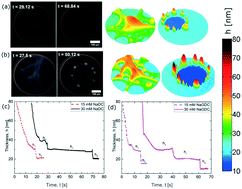Surface forces and stratification in foam films formed with bile salts
Abstract
Bile salts, especially in their aggregated or micellar form, play a critical role in health and medicine by solubilizing cholesterol, fat-soluble vitamins, and drugs. However, in contrast to the head–tail (HT) surfactants like sodium dodecyl sulfate (SDS), amphiphilic bile salts have an unusual steroid structure and exhibit a smaller aggregation number (Nagg < 20 molecules per micelle vs. Nagg > 50 for SDS). Foam films formed by micellar solutions of typical surfactants like SDS exhibit stratification manifested as stepwise thinning and coexistence of flat thick–thin regions that differ by a step-size proportional to the intermicellar distance. We consider drainage via stratification studies as an effective and insightful probe of the strength and magnitude of intermicellar interactions and resulting supramolecular oscillatory structural (SOS) surface force contribution to disjoining pressure. However, there are neither prior reports of stratification in foam films formed with bile salt solutions nor measurements of SOS surface forces. Here we report the discovery and characterization of stratification in foam films formed by aqueous solutions of four bile salts – sodium cholate (NaC), sodium taurocholate (NaTC), sodium deoxycholate (NaDC), and sodium glycodeoxycholate (NaGDC) – that have a similar steroid nucleus, but difference in conjugation sites and the number of hydroxyl groups (3 for NaC and NaTC, 2 for NaDC and NaGC). Using IDIOM (interferometry digital imaging optical microscopy) protocols we developed recently to characterize and analyze thickness variations and transitions, we find that foam films made with bile salts exhibit fewer stepwise transitions and smaller step-size than SDS solutions. Also, we measured a lower drop in surface tension and lower magnitude of thickness-dependent disjoining pressure compared to SDS solutions. We find that the bile salts with a matched number of hydroxyl groups exhibit similar properties in tensiometry and foam film studies. We show that the stratification studies can characterize the influence of chemical structure on the magnitude and range of intermicellar interactions as well their influence on drainage and stability of foam films.

- This article is part of the themed collection: Bioinspired Materials


 Please wait while we load your content...
Please wait while we load your content...
